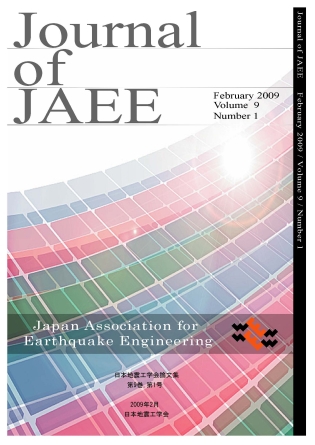All issues

Volume 12, Issue 2
Displaying 1-4 of 4 articles from this issue
- |<
- <
- 1
- >
- >|
Technical Papers
-
Diana CALDERON, Toru SEKIGUCHI, Shoichi NAKAI, Zenon AGUILAR, Fernando ...2012Volume 12Issue 2 Pages 2_1-2_20
Published: 2012
Released on J-STAGE: May 25, 2012
JOURNAL FREE ACCESSThe dynamic characteristics of the ground in Lima, capital of Peru, specifically the amplification are investigated. By using the small and large microtremor array measurements we estimated the soil velocity profiles with depths to the bedrock in many cases. These profiles were used to estimate the amplification factors. Important results are the large amplification factors at EMO, VSV, CAL and CMA (La Molina, Villa El Salvador, El Callao and Bellavista district, respectively).View full abstractDownload PDF (2353K) -
Atsushi NOZU2012Volume 12Issue 2 Pages 2_21-2_40
Published: 2012
Released on J-STAGE: May 25, 2012
JOURNAL FREE ACCESSA source model composed of super asperities was newly developed for the 2011 off the Pacific coast of Tohoku, Japan, earthquake and strong ground motions were simulated based on site amplification and phase characteristics. The constructed source model involves 9 super asperities, located off-the-coast of Miyagi through off-the-coast of Ibaragi. The agreement between the observed and calculated ground motions was quite satisfactory, especially for velocity waveforms (0.2-1.0 Hz) including near-source pulses.View full abstractDownload PDF (1834K) -
- Kanto Basin as an Example -Yutaka YUZAWA, Hideki NAGUMO2012Volume 12Issue 2 Pages 2_41-2_59
Published: 2012
Released on J-STAGE: May 25, 2012
JOURNAL FREE ACCESSWe considered a major factor of variability for the shakeability of long-period ground motion (LPGM) proposed by Yuzawa and Kudo (2011). The proposed empirical model can simply reproduce the response spectrum at a sediment site, combining the attenuation relation for the seismic basement and the site shakeability. However, the shakeability, evaluated as an average for different earthquakes, has a large standard deviation. It has large variability at around periods of 5 to 10 sec. We examined the factors that affect the variability for the shakeability, in order to improve the accuracy of the prediction of LPGM in the Kanto basin. As a result, we found that the period characteristics of the shakeability at each earthquake are dependent on the location of earthquake source. The major factor that affected the variability of the shakeability was the surface wave propagation in Kanto basin. In addition, we showed that the shakeability revaluated for limited regions improves the prediction accuracy of response spectrum of LPGM.View full abstractDownload PDF (1985K) -
Yoshiya HATA, Akira MURATA, Atsushi NOZU, Masakatsu MIYAJIMA2012Volume 12Issue 2 Pages 2_60-2_77
Published: 2012
Released on J-STAGE: May 25, 2012
JOURNAL FREE ACCESSEvaluation with high accuracy of ground motion at a damaged site is very important to analyze collapse mechanism of wooden houses. A serious disaster occurred during the 2011 Nagano-Niigata Border Earthquake. However, there were no strong motion observation stations at the wooden house damage sites during this earthquake. In this study, the seismic waveform at Yokokura Village, where a lot of wooden house damage occurred, was estimated based on empirical site amplification and phase effects. The estimated seismic waveform will be useful for rational safety assessment of wooden houses.View full abstractDownload PDF (2132K)
- |<
- <
- 1
- >
- >|